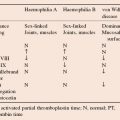Haemolytic anaemias I: General
Haemolytic anaemias are caused by a shortened red cell lifespan; the normal mean red cell life (MRCL) is 120 days. Red cell production can be increased 6–8 times by normal bone marrow and haemolytic anaemia (HA) occurs if MRCL falls to 15 days or less, particularly in the presence of ineffective erythropoiesis, haematinic deficiency or marrow disease. Haemolysis may be caused by a fault in the red cell, usually inherited (Table 13.1), or an abnormality in its environment, usually acquired (Table 13.1).
Table 13.1 Classification of haemolytic anaemia
| Hereditary | Acquired |
|---|---|
| Membrane | Immune |
| Hereditary spherocytosis, hereditary elliptocytosis | Autoimmune |
| South-East Asian ovalocytosis | Warm antibody type |
| Idiopathic or secondary to SLE, CLL, drugs, e.g. methyldopa | |
| Cold antibody type | |
| Idiopathic or secondary to infections (e.g. mycoplasma, infectious mononucleosis), lymphoma, paroxysmal cold haemoglobinuria | |
| Metabolism | |
| G6PD deficiency | Alloimmune |
| Pyruvate kinase deficiency | Haemolytic transfusion reactions |
| Other rare enzyme deficiencies | Haemolytic disease of newborn |





